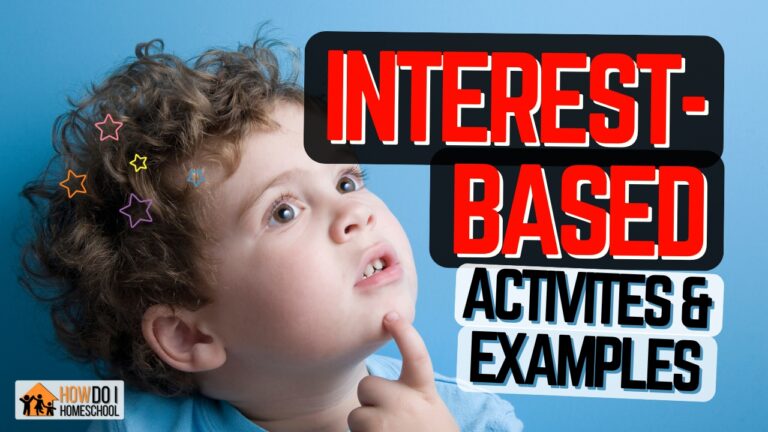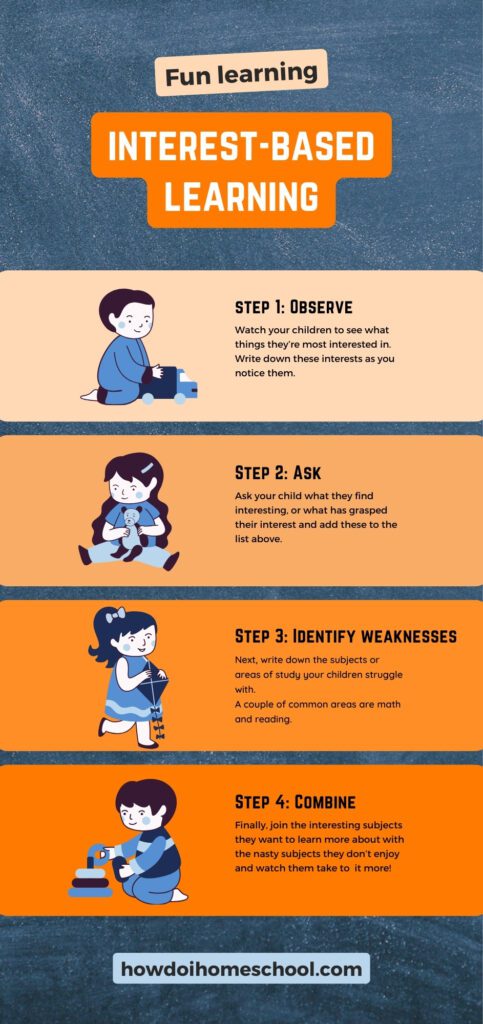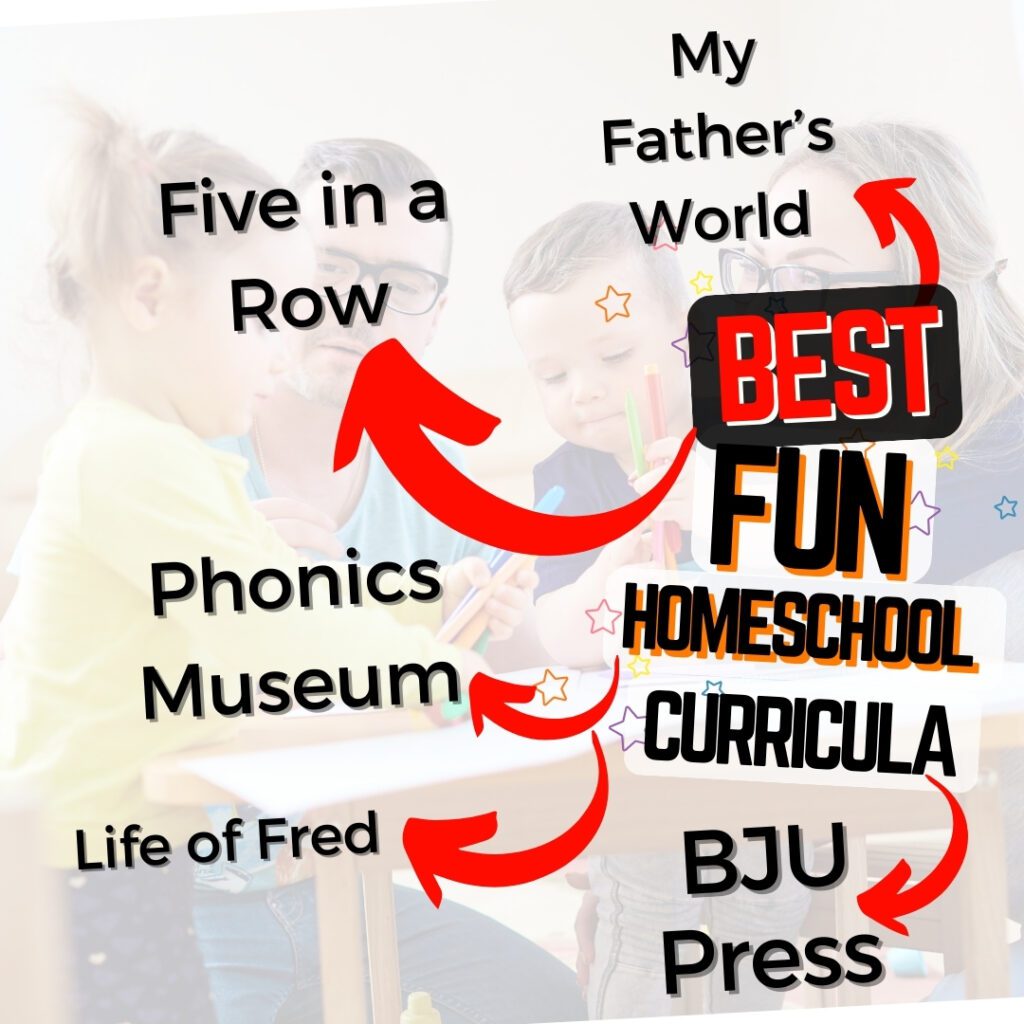Let’s learn about interest-based learning activities, examples, and more. Why? Because as a parent, it can be challenging to ensure that your children are learning and growing in a way that is engaging, fun, and effective. Homeschooling provides an opportunity for parents to cultivate a love of learning in their children while teaching them the skills and knowledge they need to succeed in life.

I hope you enjoy reading this blog post. If you want to do my course on how to homeschool, click here.
However, many homeschooling parents struggle to keep their children interested and motivated in their studies. That’s where interest-based learning comes in.
By building your child’s education around their interests, you can create a learning experience that is exciting, relevant, and enjoyable.
Whether you’re new to homeschooling or looking for ways to add more fun and excitement to your child’s education, this guide will help you create a learning experience that your children won’t even realize they’re having!
So let’s get started and discover how interest-based learning can transform your homeschooling journey!
Affiliate links are used in this post.
Step 1: Observe Natural Interest-Based Learning Activities
Children are often teaching themselves without us parents even noticing! If you can harness this natural learning, your children will be at a huge learning advantage!
Watch your children closely and write down a few of their interests.
Consider how you can combine their interests with something they need to learn.
For example, your child might like dinosaurs or excessively brightly colored unicorns. Write these interests that you notice down.
Step 2: Ask Them What Interests Them
Ask your children what they’re interested in.
Sometimes, there’s a lot more in their heads than you realize.
Combining a subject they find challenging or dull with a topic they’re super interested in will make learning much more palatable!
Example:
For example, your son might have seen a picture of a killer whale, which he’s been thinking about for a long time. Add this to the list of your children’s interests.
Step 3: Identify Hard Subjects
Identifying the subjects that your child struggles with is a crucial step in helping them improve their academic performance (using interest-based learning activities).
It’s essential to take note of the specific subjects that your child finds challenging, as this can help you to create a more targeted approach to studying and learning.
Some common subjects that students often struggle with include Math, Reading, and Latin.
However, it’s important to remember that every student is unique, and the subjects they find difficult may vary.
Step 4: Combine Hard Subjects with Interest-Based Learning Activities
Then think about combining your child’s interests – Dinosaurs, Killer whales, multicolored unicorns – with math or reading.
For example, let’s break down the Latin names of various dinosaurs (did you know dinosaur means giant lizard???). Or let’s count the number of teeth in a Killer Whale. Or let’s get a few books about impossibly colored unicorns and review the vocabulary.
You can really get quite creative here.
But you get the idea.
If you’re not feeling totally confident about homeschooling, make sure you do my Homeschool Parenting Program.
This is a Homeschool 101 course for new homeschooling parents.
It will help you quickly gain confidence on your homeschool journey and skip many mistakes I see new homeschool parents make!
But I’ve got some other tips to improve your homeschool quick smart on my YouTube channel. Check it out HERE and SUBSCRIBE!
But, you may wish to see interest-based learning theory in practice. Take a look below.
 Interest-Based Learning Activities and Examples
Interest-Based Learning Activities and Examples
Interest-based learning activities are an excellent way to engage learners and make the educational experience more enjoyable.
These activities can help students develop a love for learning by allowing them to explore their individual interests.
Below are a few examples of activities that can be undertaken across different subjects and age groups.
Science Interest-Based Learning
In Science, DIY experiments can be conducted at home, where students can conduct simple experiments using household items.
For instance, students can create a volcano using baking soda and vinegar to learn about chemical reactions.
History Interest-Based Learning
In History, students can create a time capsule with items and letters representing the current time.
They can research historical events and include artifacts that symbolize the present era. Such a project can help students understand how their present connects with the past.
Math Interest-Based Learning
In Math, real-life applications can be used to teach mathematical concepts.
Students can apply mathematical concepts to real-life situations, such as calculating the cost of a grocery shopping trip, including discounts and taxes.
Also, eating pizza and doing fractions is a favorite that interests both the mind and the stomach!
Language Arts
In Language Arts, forming book clubs with peers to discuss a common book of interest can be a great way to improve reading skills.
For instance, students can read a favorite fiction novel and analyze its themes, characters, and plot.
If you don’t know what books to suggest, check out this homeschool booklist, which is a great list of classical, Charlotte Mason, and other great book titles.
Art
In Art, keeping an art journal to document feelings, experiences, or observations through drawings and paintings can help students express themselves creatively.
For example, students can illustrate a favorite poem or song lyric while they paint a picture of how it has impressed them.
Phonics Museum by Veritas Press does a great job of combining Art, History, and Reading.
Physical Education
In Physical Education, planning and going on a nature hike or outdoor adventure can be a great way to learn about local flora and fauna while documenting findings.
We like to make this extra interesting by identifying bush food along the way. If you’re ever walking with hungry children, the bushwalk gets more and more interesting as you go along!
Technology
In Technology, engaging in coding challenges or projects based on personal interests can help students develop critical thinking and problem-solving skills.
For example, students can build a website or a simple game related to their favorite hobby.
For example, my son is interested in selling succulents. We combine a lot of math with handwriting practice (as he writes out ‘guides’), and when he’s older, we’ll expand the business online if he’s still interested.
Social Studies
In Social Studies, connecting with someone from a different culture for a virtual exchange can help students understand cultural differences and similarities.
For instance, students can exchange letters, emails, or videos discussing cultural customs and beliefs.
My son gets a lot of geography practice by talking about our sponsored children. We talk about what conditions are like in the countries our sponsor children are in and look at the geography of their countries.
Music
In Music, composing a song or creating a musical piece using an instrument or digital tools can help students express themselves creatively.
For example, students can write a song about a historical event or a personal experience.
You can do Music Appreciation through Music in Our Homeschool which will help children to get more interested in music before they start. Courses are fairly affordable. Check them out here.
Health
In Health, learning about nutrition and cooking healthy meals can help students develop healthy habits.
For instance, students can choose a cuisine of interest and prepare a balanced meal following its principles.
A friend of mine has done this to interest his child, who is a picky eater, in a wider food range. They’ve also learned geography along the way!
Foreign Language
In Foreign Language, immersing oneself in the language through movies, songs, or online interactions can help students develop language skills.
For example, students can watch a movie in the target language with subtitles and try to understand the dialogue.
Or they can pick a topic they love and look up simple vocabulary words around that topic.
Bible Interest-Based Learning Activities
There are so many ways you could tackle the Bible.
Have conversations about how lessons from the Bible can help us deal with today’s challenges.
Talk about topics like fairness, kindness, and forgiveness, and see how these ideas from the Bible can guide our actions in the world we live in now.
This way, we can learn from ancient wisdom and use it to make good choices in our everyday lives.
Furthermore, and more importantly, children can see how each passage relates to the gospel message -good news for all people through Jesus our Saviour!
Or you can just get a great Bible curriculum like Union Gospel Press (UGP), which is very gospel-centered. UGP produces engaging video lessons to teach kids the Bible. Check them out here.





